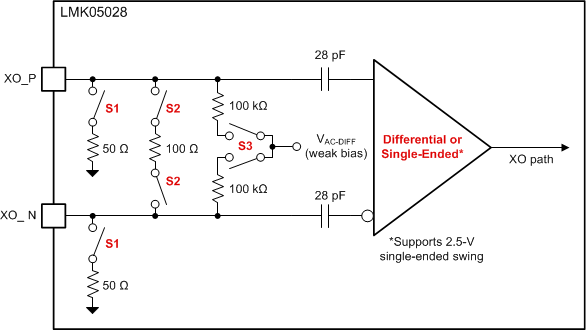ZHCSHN9A February 2018 – April 2018 LMK05028
PRODUCTION DATA.
- 1 特性
- 2 应用
- 3 说明
- 4 修订历史记录
- 5 说明 (续)
- 6 Pin Configuration and Functions
- 7 Specifications
- 8 Parameter Measurement Information
-
9 Detailed Description
- 9.1 Overview
- 9.2 Functional Block Diagrams
- 9.3
Feature Description
- 9.3.1 Oscillator Input (XO_P/N)
- 9.3.2 TCXO/OCXO Input (TCXO_IN)
- 9.3.3 Reference Inputs (INx_P/N)
- 9.3.4 Clock Input Interfacing and Termination
- 9.3.5 Reference Input Mux Selection
- 9.3.6 Hitless Switching
- 9.3.7 Gapped Clock Support on Reference Inputs
- 9.3.8 Input Clock and PLL Monitoring, Status, and Interrupts
- 9.3.9
PLL Channels
- 9.3.9.1 PLL Frequency Relationships
- 9.3.9.2 Analog PLL (APLL)
- 9.3.9.3 APLL XO Doubler
- 9.3.9.4 APLL Phase Frequency Detector (PFD) and Charge Pump
- 9.3.9.5 APLL Loop Filter
- 9.3.9.6 APLL Voltage Controlled Oscillator (VCO)
- 9.3.9.7 APLL VCO Post-Dividers (P1, P2)
- 9.3.9.8 APLL Fractional N Divider (N) With SDM
- 9.3.9.9 REF-DPLL Reference Divider (R)
- 9.3.9.10 TCXO/OCXO Input Doubler and M Divider
- 9.3.9.11 TCXO Mux
- 9.3.9.12 REF-DPLL and TCXO-DPLL Time-to-Digital Converter (TDC)
- 9.3.9.13 REF-DPLL and TCXO-DPLL Loop Filter
- 9.3.9.14 REF-DPLL and TCXO-DPLL Feedback Dividers
- 9.3.10 Output Clock Distribution
- 9.3.11 Output Channel Muxes
- 9.3.12 Output Dividers
- 9.3.13 Clock Outputs (OUTx_P/N)
- 9.3.14 Glitchless Output Clock Start-Up
- 9.3.15 Clock Output Interfacing and Termination
- 9.3.16 Output Synchronization (SYNC)
- 9.3.17 Zero-Delay Mode (ZDM) Configuration
- 9.3.18 PLL Cascading With Internal VCO Loopback
- 9.4 Device Functional Modes
- 9.5 Programming
- 9.6 Register Maps
- 10Application and Implementation
- 11Power Supply Recommendations
- 12Layout
- 13器件和文档支持
- 14机械、封装和可订购信息
9.3.1 Oscillator Input (XO_P/N)
The XO input is the reference clock for the fractional-N APLLs. The combination of XO and APLL determines the jitter and phase noise performance of the output clocks. For optimal performance, the XO frequency should be at least 48 MHz and have a non-integer frequency relationship with the VCO frequencies so the APLLs operate in fractional mode. When the TCXO input is not used by either PLL channel, the XO input determines the output frequency accuracy and stability in free-run or holdover modes.
The XO input buffer has programmable input on-chip termination and AC-coupled input biasing configurations as shown in Figure 24.
The buffered XO path also drives the input monitoring blocks as well as output muxes, allowing buffered copies of the XO input on OUT0 and/or OUT1.
 Figure 24. XO Input Buffer
Figure 24. XO Input Buffer Table 4 lists the typical XO input buffer configurations for common clock interface types.
Table 4. XO Input Buffer Modes
| XO_DIFF_TYPE | INPUT TYPES | INTERNAL SWITCH SETTINGS | |
|---|---|---|---|
| INTERNAL TERM. (S1, S2)(1) | INTERNAL BIAS (S3)(2) | ||
| 0h | LVDS, CML, LVPECL, LVCMOS
(DC-coupled) |
OFF | OFF |
| 1h | LVDS, CML, LVPECL
(AC-coupled) |
OFF | ON (1.3 V) |
| 3h | LVDS, CML, LVPECL
(AC-coupled, internal 100-Ω) |
100 Ω | ON (1.3 V) |
| 4h | HCSL
(DC-coupled, internal 50-Ω) |
50 Ω | OFF |